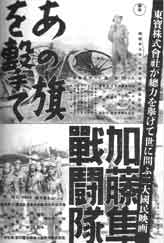Ano hata o ute
Ano hata o ute (あの旗を撃て−コレヒドールの最後−) (Filipino: Liwayway ng Kalayaan) aka Dawn of Freedom,[3] aka Fire on that Flag: The End of Corregidor[4] is a 1943 black-and-white Japanese film directed by Yutaka Abe and Gerardo de León.
| Ano hata o ute Liwayway ng Kalayaan The end of Corregidor | |
|---|---|
| Directed by | Yutaka Abe Gerardo de León |
| Written by | Yagi Koichiro, Oguni Hideo |
| Starring | Denjirō Ōkōchi, Seizaburo Kawazu, Ichiro Tsukida, Heihachiro Okawa, Fernando Poe, Leopoldo Salcedo |
| Music by | Kasuga Kunio |
| Cinematography | Yoshio Miyajima[1] |
Production company | Toho, Tagalog Pictures |
Release date |
|
Running time | 62 minutes[2] |
| Country | Japan |
| Language | Japanese Tagalog English |
Synopsis
Opening credits starts as the narrator speaking about in December 8, 1941 Japan, is accepting the challenge of the Western powers rises in arms after having had to stand by for years watching rapacious America and Britain tread upon the enslaved peoples of East Asia . Japan expeditionary forces are rushed to various places in the vast areas of Greater East Asia in order to drive out the Western powers. The first blow in the Philippines is death when Nippon warplanes raid Clark Air Base and Iba airfield on December 8.
The story of the Japanese victory at the Battle of Corregidor and the U.S. military's hasty retreat from the islands. The film presented the Japanese as Asian liberators who came to free the Filipinos from decades of colonial oppression at the same time Sub corporal Ikejima (Heihachiro Okawa) helped the boy named Toni (Ricardo Pasion) which is a younger brother of Capt. Garcia (Fernando Poe Sr.) to walk again after a car accident.
About the Film

The film was premiered in Tokyo on February 5, 1944. Originally entitled Mito Sakusan (Philippine Operation), it was changed to Ano Hatte O Utte or literally, “Tear down the Stars and Stripes.” For the Philippines, it was decided to use The Dawn of Freedom or Liwayway ng Kalayaan.
The making of the movie had gone into controversies such as, using Filipino and American POW's as extras along with the Filipino which is invited or coerced them into work along with the Japanese actors specially in the scene where the photograph under the ad copy shows two Japanese soldiers holding a group of Filipinos at bay under gun point. Without seeing the film, one would not know the Filipinos were thieves caught by vigilant Japanese soldiers protecting the local population. Whether wittingly or not, the advertisement throws the terms of this "co-production" into question, This was how the Japanese producers formed the all-star cast and crew for The Dawn of Freedom.[5]
The Dawn of freedom is of the most effective Japanese films from the Pacific War, however, the historian is always hard-put to research how a film was received upon its release. The documents available as avenues to the past are difficult to trust. and there is always some measure of speculation mixed with one's analysis. Our approach to The Daunt of Freedom's spectators in the past might take three very different paths: film criticism, studio records, and the film itself.
Cast and Staffs
Staff[6]
- Sponsor: Ministry of Army
- Production : Kazuo Takimura
- Director: Yutaka Abe, Gerardo de Leon
- Shooting: Yoshiaki Miyajima , Hiroshi Takeuchi
- Screenplay: Yagi Ryuichiro , Oguni Hideo
- Special Technical Director: Eiji Tsuburaya , Eizo Mitani
- Music: Kunio Kasuga
- Art Director: Kitao Hideo , Kitazuo
- Editor: Toshio Goto
Cast
Japanese soldiers[6]
- Denjirō Ōkōchi – Captain Hayami
- Seizaburo Kawazu
- Ichiro Tsukida – Lt. Nanoka
- Kaizaburo Kawazu – Captain Washio
- Fujita Shindo – Susumu
- Ichiro Tsuneda – Lt. Nonaka
- Nakamura Satoshi – Nakamura Iku
- Masuki Jun – Senior officer Yamada
- Satoshi Komori – Senior officer- Muramatsu
- Heihachiro Okawa – Sub Corporal Ikema Ishihara
- Tanaka Haruo – Lt. Sakuragi (military doctor)
Filipino soldiers and civilians
- Fernando Poe Sr. – Captain Gomez
- Leopoldo Salcedo – Captain Reyes
- Ángel Esmeralda – Lt. Garcia
- Norma Blancaflor
- Rosa Aguirre
- Ricardo Pasion – Toni (Tony)
US Army and officers
- Burt Leroy
- Johnny Arville – Captain Adams
- Frankie Gordon
- Franco Garcia – Captain Smith
- E.S. (Ted) Lockard – US Army men (opening scene)
- Weldon Hamilton – Bataan surrender scene
- Burton C. Galde – Bataan surrender scene
Availability
Dawn of freedom was released in DVD on January 20, 2015 by Deagostini .
References
- Stuart Galbraith IV (16 May 2008). The Toho Studios Story: A History and Complete Filmography. Scarecrow Press. p. 56. ISBN 978-1-4616-7374-3.
- (in Japanese) http://www.jmdb.ne.jp/1944/bt000090.htm accessed 20 January 2009
- Baskett, Michael (2008). The Attractive Empire: Transnational Film Culture in Imperial Japan. Honolulu: University of Hawai'i Press. ISBN 978-0-8248-3223-0., pp. 100-102
- https://mahimahi.uchicago.edu/admin/ceas/asset.php?assetid=0001566&titlestart=F accessed 20 January 2009
- http://pinoykollektor.blogspot.com/2011/10/48-dawn-of-freedom-philippine-wwii.html
- https://www.allcinema.net/prog/show_c.php%3Fnum_c%3D134804&usg=ALkJrhgJ6KkrMpGuMz0Unb7hAk9utlYAlg
- Baskett, Michael (2008). The Attractive Empire: Transnational Film Culture in Imperial Japan. Honolulu: University of Hawai'i Press. ISBN 978-0-8248-3223-0.
External links
Article on history and analysis: http://www-personal.umich.edu/~amnornes/Dawn.pdf